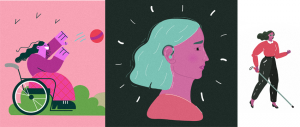Part I – Accessibility is not a barrier to design

Accessibility and usability are two essential pillars of brilliant user experience design. As a UX designer, your product will not live up to its full potential if the design isn’t inclusive of everyone. This includes the target users, users with impairments, users from varied cultures, countries, etc. Understanding their needs is the key to crafting an accessible experience.
What is accessibility?
Accessibility is simply a concept of designing a product or service that will be used by all however they encounter it. It doesn’t limit to people with disabilities but all potential users. Accessibility has a firm benefit, i.e., better design for all. Accessibility doesn’t only mean doing the right thing; it often benefits all users. Let’s take an example of video captions that helps people with hearing difficulties. It also helps a user to watch videos on mute, people, or those consuming the content in a loud environment. High-contrast text is created to help people with vision difficulties. It also helps people with perfect eyesight to use an app outside. When designers design for all ability levels, all users can use and enjoy the product and services. Accessibility works on the universality of usability. Which means how well all users can access a product or service.
Accessibility is not usability
Being part of UX, they also have their differences. Usability relates to how easy things are to use. In other words, it measures how well a user in a specific context interacts with a design/product to achieve a goal efficiently. It does not refer to whether or not all users can access the product equally. Accessibility works with universal usability, meaning how well all users can access a product. It tackles whether or not all users have an equal user experience.
Accessibility is not a barrier to design
Design with accessibility can be challenging through certain constraints, yet accessibility will result in a much better product for all users. Accessibility makes designers think critically, and their solutions surprise customers. Let’s have a look at some real-life design examples.
1. Closed captions or subtitles
In a noisy environment, closed captions have helped people to understand the content. Subtitles have allowed people to understand movies and tv shows in different languages. Closed captions were intended for people with hearing disabilities, however, they benefited everyone.
2. Automatic doors
Automatic doors were designed for people in wheelchairs or crutches so that they could enter and exit buildings hassle-free. But these doors are helpful for everyone. Think about the time when your hands were full and how these automatic doors benefited you.
3. Voice control
Siri, Alexa, and Google Assistant were intended to help visually impaired people. These products have helped them to navigate their devices through their voices. Nowadays, everyone uses voice control to get informed about the weather or time zones.
4. Screen reading (text to speech)
To help the visually impaired understand the written content in front of them, Screen reading was designed. This AI tool has been really helpful. For others, having text spoken to you makes it easier to catch mistakes when it is an essay or an article.
Design always starts with empathy

Accessible design isn’t familiar to many people and requires in-depth research. It is helpful when designers put themselves in their users’ shoes to identify their needs. Accessibility research includes observing the environment of people with disabilities, Interviewing them. This knowledge will help the designers to create an accessible product.
Benefits of Accessible Design
1. Inclusion Inspires Innovation
Accessibility, despite who they are intended for, helps everyone. It allows users to interact with products in various ways. This makes the product more user-friendly. Accessibility features and services, despite who they were intended for, end up helping everyone. It allows users to interact with products in several ways, making them more user-friendly. Accessible products make it easy to be flexible and fit the consumer’s needs.
2. More Customers
There are over one billion Neurodiverse people in the global market. Designing accessible products will only expand market reach and income. They are great customers and will bring value to any business.
3. Expand your brand
Accessible design helps to increase brand credibility. This would result in an increased business reputation. Brands like Apple have paved the way for accessibility. They get the spotlight and an increased number of users.
Accessibility Principles: POUR
POUR is an acronym that describes functional accessibility. People face many technology challenges with disabilities. These challenges can be described using one of the POUR principles.
1. Perceivable
Perceivability means identifying content and interface using the senses. For some, this means perceiving a product visually, while for others, it might be a matter of sound or touch.
2. Operable
A product is said to be operable when users can successfully use the necessary interactive elements like buttons, navigation, etc. They can be identified by clicking or tapping, or using voice commands to operate the interface.
3. Understandable
This technology is consistent and predictable in its design, using patterns and concise. Users should be able to remember how to use the interface.
4. Robust
The last letter in POUR stands for robust. It means the design needs to be robust enough to be able to get accessed on a variety of devices, including assistive technology.
Accessible design means designing for everyone

Each designer should aim to create digital products that the widest range of users can use. Designing a product means uniting people, not separating them by strengths and weaknesses. When you intend to help people with disabilities, you end up helping everyone. The product’s flexibility makes it easier for users to adapt it based on their needs.
Read more: Part II – Accessibility is not a barrier to design

